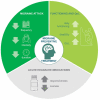Reducing the Burden of Migraine: Safety and Efficacy of CGRP Pathway-Targeted Preventive Treatments
- PMID: 35955976
- PMCID: PMC9369309
- DOI: 10.3390/jcm11154359
Reducing the Burden of Migraine: Safety and Efficacy of CGRP Pathway-Targeted Preventive Treatments
Abstract
Migraine is a highly disabling and often chronic neurological disease that affects more than one billion people globally. Preventive migraine treatment is recommended for individuals who have frequent and/or disabling attacks; however, many of the medications used for migraine prevention (e.g., antiepileptics, antidepressants, antihypertensives) were not specifically developed for migraine, and often have limited efficacy or poor tolerability. Four monoclonal antibodies targeting the calcitonin gene-related peptide (CGRP) pathway, which is believed to play a crucial role in the pathophysiology of migraine, have been approved by the US Food and Drug Administration for the preventive treatment of migraine in adults. All four migraine-specific treatments have demonstrated efficacy based on reductions in monthly days with migraine for patients with both episodic and chronic migraine, including those with comorbidities. They have also demonstrated favorable safety and tolerability profiles. Based on these accounts, CGRP pathway-targeted monoclonal antibodies have the potential to revolutionize preventive treatment for patients with migraine.
Keywords: CGRP; cardiovascular safety; efficacy; migraine; safety and tolerability.
Conflict of interest statement
G.M. Nissan has served as a speaker for Amgen Inc., Biohaven Pharmaceuticals, Eli Lilly and Company, and Teva Pharmaceuticals. R. Kim has served on the speakers bureau for AbbVie, Biohaven Pharmaceuticals, Eli Lilly and Company, and Teva Pharmaceuticals and as a site principal investigator for Amgen and Eli Lilly and Company. J.M. Cohen is a former employee of Teva Pharmaceuticals. L.J. Krasenbaum and K. Carr are employees of Teva Pharmaceuticals. M.J. Seminerio is a former employee of Teva Pharmaceuticals. V. Martin has no conflicts of interest to disclose. Medical writing support was funded by Teva Pharmaceuticals (West Chester, PA, USA).
Figures
Similar articles
-
Burden of migraine with acute medication overuse or psychiatric comorbidities and treatment with CGRP pathway-targeted monoclonal antibodies: A review.Medicine (Baltimore). 2023 Jun 9;102(23):e33874. doi: 10.1097/MD.0000000000033874. Medicine (Baltimore). 2023. PMID: 37335663 Free PMC article. Review.
-
Hypervigilance, Allostatic Load, and Migraine Prevention: Antibodies to CGRP or Receptor.Neurol Ther. 2021 Dec;10(2):469-497. doi: 10.1007/s40120-021-00250-7. Epub 2021 Jun 2. Neurol Ther. 2021. PMID: 34076848 Free PMC article. Review.
-
Efficacy and Safety of Galcanezumab for the Preventive Treatment of Migraine: A Narrative Review.Adv Ther. 2020 May;37(5):2034-2049. doi: 10.1007/s12325-020-01319-9. Epub 2020 Apr 21. Adv Ther. 2020. PMID: 32319039 Free PMC article. Review.
-
Monoclonal antibodies blocking CGRP transmission: An update on their added value in migraine prevention.Rev Neurol (Paris). 2020 Dec;176(10):788-803. doi: 10.1016/j.neurol.2020.04.027. Epub 2020 Aug 2. Rev Neurol (Paris). 2020. PMID: 32758365 Review.
-
Retracted: Calcitonin Gene-Related Peptide (CGRP) Antagonists: A comprehensive review of safety, efficacy and prescribing information.J Clin Pharm Ther. 2022 Jan;47(1):i. doi: 10.1111/jcpt.13445. Epub 2021 Jul 12. J Clin Pharm Ther. 2022. Retraction in: J Clin Pharm Ther. 2022 May;47(5):711. doi: 10.1111/jcpt.13584. PMID: 34254331 Retracted. Review.
Cited by
-
Healthcare Utilization, Costs, and Treatment Discontinuation in Adults with Episodic Migraine Initiating Galcanezumab Versus Rimegepant: A US Retrospective Claims Analysis.Adv Ther. 2025 Feb;42(2):918-934. doi: 10.1007/s12325-024-03072-9. Epub 2024 Dec 16. Adv Ther. 2025. PMID: 39680312 Free PMC article.
-
Consensus-Based Recommendations on the Use of CGRP-Based Therapies for Migraine Prevention in the UAE.Neurol Ther. 2023 Dec;12(6):1845-1865. doi: 10.1007/s40120-023-00550-0. Epub 2023 Oct 4. Neurol Ther. 2023. PMID: 37792218 Free PMC article.
-
Risk of Migraine after Traumatic Brain Injury and Effects of Injury Management Levels and Treatment Modalities: A Nationwide Population-Based Cohort Study in Taiwan.J Clin Med. 2023 Feb 15;12(4):1530. doi: 10.3390/jcm12041530. J Clin Med. 2023. PMID: 36836064 Free PMC article.
References
-
- GBD 2017 Disease and Injury Incidence and Prevalence Collaborators Global, regional, and national incidence, prevalence, and years lived with disability for 354 diseases and injuries for 195 countries and territories, 1990–2017: A systematic analysis for the Global Burden of Disease Study 2017. Lancet. 2018;392:1789–1858. doi: 10.1016/S0140-6736(18)32279-7. - DOI - PMC - PubMed
-
- Buse D.C., Reed M.L., Fanning K.M., Bostic R., Dodick D.W., Schwedt T.J., Munjal S., Singh P., Lipton R.B. Comorbid and co-occurring conditions in migraine and associated risk of increasing headache pain intensity and headache frequency: Results of the migraine in America symptoms and treatment (MAST) study. J. Headache Pain. 2020;21:23. doi: 10.1186/s10194-020-1084-y. - DOI - PMC - PubMed
Publication types
Grants and funding
LinkOut - more resources
Full Text Sources
Research Materials


